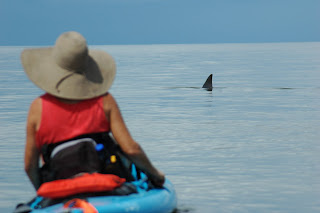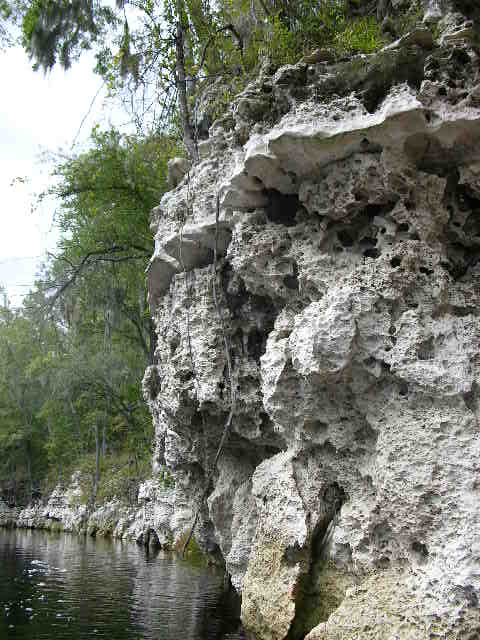I’m often asked how many times I’ve paddled this river or that one. But unfortunately, after 26 years leading these tours, I’ve lost track. One day I might pull out my old records and count, but for now, I’m less focused on the number of times I’ve paddled the 70+ waterways on my tour list than on the relationships I’ve established with them.
Relationships with rivers are like those with people. Some are born of simple geography, like the next-door neighbor who, through nothing more than occasional chats over the fence, becomes as familiar as family. Others are the stuff of chemistry, sparked to life by something as simple as a glance, at the driver in the car next to us at a stop light; at a person studying at the next table in the library; at a stranger who sits next to us at a lecture…..at a glistening pool of blue water that we stumble upon, deep in a Florida forest. We turn our head, we look up from our book, we round the bend in a forest trail, and our eyes are met by a beauty unlike any we have seen before. We are consumed by a wild, breathless attraction.
There’s magic in those first moments of breathless attraction to a person or place. But, it’s not until we come to know them deeply—their flaws, their blemishes, their troubled past and underlying illnesses—that we develop the kind of true, deep connection that moves us to do anything to protect them.
Suwannee (Monday 8/07 & Thursday 8/24) is my famous friend. You’d never know it to meet her. Every warm summer day, people flock to her banks and refresh in her cool waters. Paddlers skim her dark surface year-round. Her human suitors have even written songs about her (which I hear all-too-often ;o). But she remains humble. Aside from the occasional splash of a leaping sturgeon and the gentle percussion she plays against the rocks of the middle river---"popping,” “blipping,” “glugging” and “tinkling” are words I’ve used when trying to describe the beautiful music she plays in the small pockets and chambers at the water’s edge---the Suwannee carries herself with a quiet, unassuming elegance.
Cedar Keys (Friday 8/11 & Tuesday 8/29) are the elders I don’t see often enough, the ones from whom I always walk away feeling rejuvenated, reconnected and vowing to visit more often. In other cultures, they would be revered as tribal shamans, keepers of ancient knowledge of our lands and waters, passed to them by ancestors of a hundred generations. They remind us, in the quiet way of all great teachers, that all nature is sacred; that we should listen.
Those who spend time with these island elders--Atsena Otie, Hog, Deer, McClamory, Snake, Seahorse, too many to name—and listen with their heart, hear stories ancient as the sand and the tides, whispered on sea-breezes and scratched into rustling parchments of palm fronds. Woven through these stories and connecting them by an unbroken thread back to the first Floridians, is a single, powerful theme: this land has stood for millennia and could stand millennia more, if we learn the lessons of our predecessors and let them guide us forward.
Prairie Creek (Monday, August 14) is one of my more reclusive friends. She’s the neighbor everyone loves, but who only receives guests when the mood (and in her case, water levels) so move her. When allowed to enter, visitors to Prairie Creek’s inner sanctum find themselves immersed in that special kind of wonderland found only on narrow creeks that wind through towering swamp forests of bald cypress, ash, tupelo and red maples. Birders are treated to a nice mix of waders, water birds and species more associated with the forest in the creek’s upper end, near Newnans Lake. Many species of wood peckers, warblers (including prothonotaries and parulas, in summer), and all manner of perching birds love it here. Owls—especially barred owls—are frequently seen. For years, we were welcomed on every paddle, to a certain section of the forest by a beloved barred owl who became something of a mascot. Limpkins are surprisingly common in the occasional sunny spots. Deer and wild hogs are common too. Quiet paddlers might spot a hog enjoying the clay-lined “wallow” we pass on a high spot near the creek’s edge. Best of all, this natural wonderland is practically in Gainesville’s back yard.
Steinhatchee River (Thursday, 9/15) is as moody as one would expect from a recluse who lives quietly in a remote corner of the Big Bend region of the Gulf Coast. As with all recluses, you never know what you’re going to get when you visit her. On cool winter days, when the east winds blow the coastal waters seaward, she might surprise you with waters so low you’re forced to portage a 100-foot expanse of beautifully-sculpted limestone. Other days, she’ll be surging with flood waters delivered from her birth mother, Mallory Swamp. On those days (the vast majority) when water levels are ideal, she’ll welcome you with an enticing spread of habitats, ranging from a narrow stream with high banks crowded with upland shrubs and trees to an open, sunny section lined with coastal forests and salt marshes. In certain seasons, this stretch offers slow, mindful paddlers an incredible floral display.
Ocklawaha (Monday, 8/21 & Friday, 9/22) and I are the kind of friends who often finish each other’s sentences. When a customer asks what wildlife we might see and I begin to rattle off names, she interjects a chorus of birdsong, chirps, fizzing insects and the occasional grunt of a pig frog for good measure. Likewise, when she wails through the trap doors of Kirkpatrick Dam, I feel compelled to explain to my companions that the lament they’re hearing is that of a river held captive since the 1960’s, when the State of Florida attempted to gouge a canal across Central Florida from the St Johns River to the Gulf of Mexico. Fortunately, that assault was stopped after a couple of years, but not before this dam was completed, blocking the natural flow and impounding 16 miles of the river in a huge pool called Rodman Reservoir. Efforts to drain this reservoir and restore the river’s life-giving flow are ongoing, led by groups like Florida Defenders of the Environment. One day, hopefully soon, the growing chorus of sympathetic voices will end the dam and allow the Ocklawaha to resume her ancient song, unfettered.
Waccasassa and Wekiva Rivers (Wednesday 9/06) are the beautiful sisters who live beyond the outskirts of town. Few people know them, or try. Those who do and who follow them along their spring-water trails into the forests and listen closely to their whispered stories, are often mesmerized. On our excursions into this realm, I often hear nothing but the dip and swish of paddles, as our kayaks glide through a series of habitats that transition from sun-washed, coastal mixed-hardwoods into a shaded hydric hammock where swamp dogwoods, buttonbush, yaupon holly, hawthorns and red buckeye form an intimate understory overtopped by a closed canopy of tall oaks, green ash, pignut hickories and river elms. Birders smile as their binoculars find kites (swallow-tailed and Mississippi), ospreys, kingbirds, herons and egrets of all the common clans, belted kingfishers, warblers and perchers. As everywhere in North Florida, the once-elusive limpkins have become relatively common. Sharing in the bounty of mollusks and crustaceans are yellow-crowned and black-crowned night herons.




